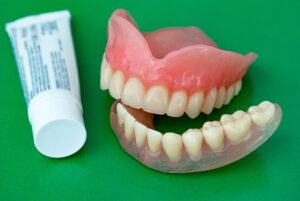
Dentures are a popular way to replace missing teeth because they’re a cost-effective method to restore so much of your ability to eat and speak like you used to. Usually, the base of your false teeth forms a suction against your gums to remain in place. Because your jawbone begins to deteriorate after tooth loss, however, they eventually begin to loosen and may require adhesive to stay put.
If you have visited your local store or gone online to purchase denture glue, you probably noticed that there’s a wide variety to choose from. How do you pick which one to use? Which is best for you? Keep reading to learn more about 3 types of adhesives so that you can pick the right one for your circumstances!
Adhesive #1: Cream
One of the strongest types of denture glue is in the form of a cream and can be used on both full and partial dentures. It typically is packaged in a tube which you can use to apply small amounts to your prosthetics where they press against your gums before you insert them. They form an all-day hold that can seal out food particles, and some even boast a minty flavor to enhance their appeal.
You may want to check the ingredients list on the packaging before you buy, however, because some creams contain zinc. This has been known to cause adverse reactions such as nerve damage, tingling, or numbness with long-term or excessive use.
To apply, squeeze small amounts to the undersurface of your moistened dentures. Then put them into your mouth and bite down for a moment or two for a secure hold.
Adhesive #2: Powder
Denture powder can be sprinkled directly onto your dentures. Unlike creams, which are applied to specific parts of your dentures, this alternative covers the entirety of the surface of your dentures, instead. Some patients feel that this type of denture glue is more convenient because it requires less manipulation to form a bond once they put their dentures into their mouths. It can tightly hold your restoration in place for up to 12 hours, and there are zinc-free formulas available.
You can use it by sprinkling it evenly onto your wet dentures, shaking off any excess powder, then putting them in your mouth and holding them in place to allow a bond to form.
Adhesive #3: Strips
This method of attachment is often considered the most convenient to apply. It consists of strips that are pre-cut and pre-treated with just the right amount of product to prevent any overflow or excessive oozing that you might get with creams. Simply peel one of the strips open, moisten it in water, apply it to the underside of your false teeth, then insert them and bite down until they feel firmly applied.
Depending on your preference and ease of use, you can determine which of these choices works best for you!
About the Author
Dr. Evan Pedersen has 10+ years of experience providing a wide range of dental services to enhance his patients’ oral health. He studied Molecular and Microbiology at the University of Central Florida and then earned his DMD from the prestigious Harvard School of Dental Medicine in Boston, Massachusetts. He is committed to providing top-quality care and uses state-of-the-art dental technology to ensure you’re getting the most current treatments available. If your dentures no longer fit well or become dislodged even with adhesive, you’re welcome to request a consultation appointment on the website or by calling (512) 777-0866.
